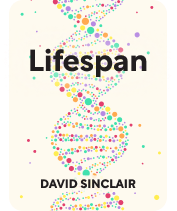

This article is an excerpt from the Shortform book guide to "Lifespan" by David Sinclair. Shortform has the world's best summaries and analyses of books you should be reading.
Like this article? Sign up for a free trial here .
What is David Sinclair’s Lifespan about? What is the key message to take away from the book?
In Lifespan, David Sinclair discusses why aging happens, how we can prevent it, and how we might create a world where nobody has to die of old age. He believes that old age is a deadly disease, and he’s dedicated his life to curing it.
Below is a brief overview of the key themes.
Lifespan: Why We Age and Why We Don’t Have To
For all of recorded history, people have seen aging as an inevitable fact of life. Biologist and geneticist David Sinclair disagrees: He believes that old age is a deadly disease, and he’s dedicated his life to curing it.
In his book Lifespan, David Sinclair discusses why aging happens, how we can prevent it, and how we might create a world where nobody has to die of old age. This guide explains Sinclair’s ideas and provides background information to make complex biological concepts more accessible to the average reader.
Sinclair earned his Ph.D. from the University of New South Wales in Australia. He’s currently co-director of the Paul F. Glenn Center for Biology of Aging Research at Harvard University, where he is also a professor of genetics.
Sinclair believes it’s not only possible but inevitable that we’ll learn to overcome the aging process. New medicines and technologies will increase our maximum lifespan and years of health until eventually humans won’t have a maximum lifespan—we’ll stay young and healthy forever. In fact, we’ve already taken steps toward overcoming aging with treatments such as stem cell therapy, which alleviates some degenerative symptoms of aging like arthritis and Alzheimer’s disease.
Sinclair acknowledges that he’s making a remarkable claim, but he points out that many other human achievements were once similarly “impossible.” For example, even 100 years ago it would have seemed impossible that we’d ever have tools precise enough to edit DNA, yet CRISPR and other genetic engineering technology let us do exactly that.
Part 1: Why Do We Age?
Sinclair says that humans have always accepted aging as a fact of life, but relatively few people have questioned why it has to happen.
The oldest theory, dating back to Aristotle, is that we age and die for the good of the species, to “make room” for the next generation. This is part of the theory of group selection—evolving to benefit the species, rather than the individual—but that theory fell out of favor in the 1950s.
The current theory is that we evolved to survive long enough to reproduce, with no concern for what happens after that. In evolutionary theory, this is known as antagonistic pleiotropy: The same genes that help us survive and reproduce also cause us to deteriorate once we’re past breeding age.
Supporting this theory is the fact that species historically evolved for either rapid breeding or long lifespans, but never both. Scientists believed this was due to limited resources—building a strong, healthy, and long-lasting body requires a lot of energy and resources, and so does raising a lot of offspring. Very few species would have had enough resources to support large numbers of offspring that also survive for a long time.
The “DNA Damage” Theory of Aging
Why we age may be an interesting question, but Sinclair is more concerned with how we age. One popular theory is that our bodies break down due to progressive damage to our DNA—this damage could result from random mutations, radiation (such as from the sun), pollution, and countless other causes. Basically, the genetic damage keeps accumulating until our cells can’t function correctly anymore.
However, Sinclair says that cloning technology disproves the DNA damage theory of aging: We can use cells from an old, sick animal to clone a young and healthy one, which wouldn’t be possible if changes to DNA directly caused the effects of aging.
The “Information” Theory of Aging
As a counterpoint to the DNA damage theory, Sinclair developed the “Information Theory of Aging.” His theory states that we age due to an accumulation of epigenetic damage, rather than genetic damage.
First, it’s important to understand that every cell in your body, from skin to hair to brain tissue, has the exact same DNA. The epigenome, consisting of proteins wrapped around the DNA, controls which genes in any given cell are “on” and which are “off.” That’s how we end up with all of those different types of cells—it’s not a result of the information encoded in the genes, but rather how your body uses that information. Therefore, changes to the epigenome can create changes in our bodies without actually altering our genes.
Sinclair calls these epigenetic changes “noise,” similar to radio static or garbled transmission. The goal of his research is to figure out how to clear up that noise so that the genetic messages come through loud and clear like they did when we were young.
According to Sinclair, the Information Theory of Aging is good news, because fixing epigenetic damage is much easier than repairing the DNA itself—in fact, Part 2 of this guide is all about ways to do just that.
Part 2: Treating the Disease
Sinclair says that throughout recorded history, we’ve always accepted aging as something that just happens to people. However, he argues that aging is actually a treatable disease.
In fact, old age shares several key traits with cancer:
- Both diseases are more common in older people (by definition, in the case of old age).
- Both diseases used to be considered impossible to treat, let alone cure.
- Both diseases are eventually fatal if left untreated.
If aging is a disease, Sinclair argues, then things like arthritis, dementia, organ failure, and frailty are merely symptoms. The question then becomes: How do you cure this disease?
Sinclair suggests a number of different ways to treat aging, either by delaying the symptoms or (in some cases) actually reversing the damage. We’ll start by discussing what you can do yourself, then we’ll go over how medical science and technology can prolong our lives and years of good health, and we’ll conclude with methods to fully repair epigenetic damage—Sinclair’s theory for how to truly cure the disease of old age.
Take Advantage of Hormesis
Sinclair says that we can prolong our own life and health through hormesis: A phenomenon by which our bodies become stronger in response to stressors like hunger, extreme temperatures, and physical damage. Hormesis activates numerous survival mechanisms, such as conserving resources and repairing cellular damage. Sinclair believes we can take advantage of hormesis not just to extend our lives, but to improve our quality of life as well.
We already employ hormesis in several ways, such as dieting, exercising, and sitting in saunas. However, Sinclair says that recent and upcoming scientific advancements will allow us to control these processes more effectively and efficiently—for example, we might be able to use an injection to strengthen our muscles without the need for exercise.
Sinclair recommends intermittent fasting (IF) as a way to trigger your body’s stress responses without causing malnutrition. He suggests several different variations of IF, saying that it’s currently unclear which method is best, but all are beneficial:
- Set aside 8 hours a day where you’re allowed to eat, and fast the rest of the time (the 16:8 method).
- Reduce your calorie intake by 75% for 2 days a week (the 5:2 method).
- Eat no food for a week once per quarter.
Sinclair also says that a vegetarian diet can activate hormesis. The relatively low levels of certain proteins (as compared with meat) can trigger our survival mechanisms in the same way that calorie restriction does.
Finally, Sinclair says that exercise (which, by definition, puts stress on our bodies) can greatly extend our lifespans. For example, researchers have found that exercise lengthens and protects telomeres. Telomeres are small complexes of DNA and proteins at the ends of our chromosomes that get shorter each time a cell divides. When the telomere runs out, the cell stops dividing—leading to many of the problems of old age. Therefore, lengthening telomeres can literally keep our bodies younger for longer.
Sinclair adds that exercising in low temperatures appears to boost the youthening effects of exercise, most likely due to combining the stress of working out with the stress of being exposed to cold.
Extending Health, Not Just Life
Sinclair says that our current medical efforts are misdirected if we want to extend both life and health. Modern medicine prefers to treat one problem at a time, then send the patient away until the next problem arises. As we age, those problems become more frequent and more severe—in other words, we deteriorate. Eventually the treatments can no longer keep up, the body fails completely, and we die.
However, age is the single biggest risk factor for numerous conditions, ranging from heart disease to cancer to Alzheimer’s. Therefore, if we could prevent—or better yet, reverse—the effects of aging, then average life expectancy and quality of life would both skyrocket.
Killing Senescent Cells to Preserve Other Cells
As we get older, our cells start to shut down, which causes a lot of the deterioration that we experience as we age. Sinclair believes that destroying those cells before they cause too much damage can significantly extend both life and health.
Cells that are no longer able to divide, or that suffer genetic or epigenetic damage too severe to repair, can enter senescence: They don’t function anymore, but they also don’t die when they should (leading some researchers to refer to them as “zombie cells”). Furthermore, senescent cells can cause other cells to enter senescence, so the process only accelerates once it’s begun.
Sinclair says that senescent cells send out chemicals that cause inflammation in surrounding tissue, which is associated with symptoms of aging. Therefore, it seems likely that senescent cells are responsible for many of the negative effects of old age.
Researchers found that destroying senescent cells in mice extended their remaining lifespans by a third or more and reversed many of the effects of aging; in theory, the same principle should apply to humans. To that end, researchers began testing senolytics (“senescence destroyers”) on people in 2018, though Sinclair says it could be years before we have any conclusive results about their effectiveness and safety for human patients.
Protecting Health With Technology
While the focus of Sinclair’s work is undoing the damage caused by aging, he also believes that technology will extend our years of health by letting us recognize and treat diseases before the symptoms even begin. Improved DNA sequencing techniques will allow us to find genetic markers and risk factors for numerous conditions, while biometric devices (like smartwatches) can track our vital signs and warn us of potential problems. Furthermore, Sinclair believes that having access to this detailed information will allow experts to design diets, exercise programs, and treatment regimens that are custom-tailored to your genetics and lifestyle.
Of course, sharing such intimate personal data comes with enormous privacy and security concerns. Sinclair says we’ll each have to decide how much we’re comfortable with sharing, but he personally believes it’s more than worth the risk—much like how our cell phones collect tons of data about us, but we still use them. In fact, Sinclair shares that he uses biometric devices himself, and that the insight he gains from them is worth the potential risks.
On a less personal level, Sinclair says that improved technology such as new vaccines and 3D-printed organs—which don’t force you to wait and hope that a match becomes available—will enable us to avoid diseases and recover from grievous injuries or surgeries more easily.
Clearing Epigenetic “Noise” With Sirtuins
When it comes to repairing epigenetic damage, Sinclair’s work focuses on sirtuins—enzymes that regulate the epigenome. He believes he can reverse many of the effects of aging by bolstering our sirtuins because they’re involved in everything from repairing DNA to suppressing inflammation—all of which they accomplish by activating or deactivating certain genes in response to certain stressors.
We’ve already discussed Sinclair’s theory that DNA damage doesn’t directly cause aging. Now he adds that sirtuins have to move away from their usual functions in order to repair DNA damage. As we age and start suffering from more and more problems, this leads to two issues: First, the sirtuins aren’t able to get back to their positions before they have to rush out to repair more damage. Second, sometimes they don’t return to the correct positions. These two things lead to epigenetic chaos—genes that should be active are deactivated, and vice versa.
Therefore, manipulating sirtuins to work more effectively—which scientists have done in mice with drugs like resveratrol—helps combat the effects of aging and extends life. The next step, Sinclair says, is to find drugs that cause the same effects in humans.
Turning Back the Clock With Yamanaka Factors
Sinclair believes that the true cure for aging may be a set of four genes, called Yamanaka factors, that reverse aging in cells—not just the effects of aging, but aging itself. Shinya Yamanaka, the stem cell researcher who discovered these genes’ potential, showed that they could cause adult cells in a petri dish to revert to immature stem cells. Those stem cells could then re-mature into young, healthy cells of any type.
Sinclair believes that it will someday be possible to use Yamanaka factors, along with other treatments, to completely undo epigenetic damage and even revert senescent cells into healthy ones, thereby resetting people’s biological clocks. He even says it might become possible within our lifetimes, though he admits that’s an optimistic prediction.
The author acknowledges that this sort of genetic de-aging therapy is a work in progress: He suspects that it’ll take at least another decade to develop methods that are both safe and effective for humans. However, Sinclair’s own laboratory has made great strides already, and he truly believes that this procedure (or one like it) will someday keep us young and healthy indefinitely.
Part 3: A World Without Aging
In the final part of Lifespan, Sinclair imagines what it might look like to live in a world where people live forever. He speculates on how we might create such a world, and he discusses the potential pros and cons of doing so.
Causes for Concern
In imagining a world where people never die, Sinclair starts by outlining some of the potential problems. Some of his chief concerns are:
- Stagnating scientific and social advancements. Sinclair says that progress doesn’t happen by winning over the opposition, but because the (usually older) opposition eventually dies off—if people start living for hundreds of years, that won’t happen.
- Widening wealth gaps as rich people live longer and invest more in politics to get even richer at everyone else’s expense. To make matters even worse, the wealthy will almost certainly have access to life-extending treatments long before poor and working class people do.
- Overpopulation leading to starvation, mass poverty, and worsening climate change
Causes for Optimism
Despite the risks, Sinclair says that there are numerous reasons for us to be optimistic about living forever. In short, he believes that people can and will overcome any of the previously mentioned problems through human ingenuity and grit.
Scientific and Economic Boosts
Sinclair imagines a world where people have the wisdom and experience of the elderly with the strength and energy of the youth. He believes that, with such people driving society, our rates of productivity and advancement would skyrocket—the exact opposite of the stagnation he talked about in the previous section.
Sinclair also says that people staying healthier for longer will be a boon to the economy. As it stands now, elderly people stop contributing to the economy at the same time that they become expensive to care for, which places an enormous burden on the economy. Therefore, keeping people healthier for longer will create more wealth; that wealth, in turn, will fund research and treatments to keep more people healthier for longer.
Overpopulation Concerns May Be Overblown
Estimates of the maximum human population that Earth can support range anywhere from 8 billion (which we’ve already reached) to 16 billion. Sinclair says that a few estimates even place the maximum at around 100 billion people.
More to the point, most of those estimates don’t account for technological and societal advancements. In other words, they estimate the current maximum population that Earth could sustain, but by the time we reach that number, the true maximum could be far higher.
In fact, Sinclair says we should question the idea that there even is a maximum human population—it seems obvious that there must be a limit, but there’s no solid evidence to prove it. Perhaps technology will keep pace with our ever-growing population, offering ways to house and feed more people than we’d ever thought possible. For example, we could imagine floating cities, food replicators like those on Star Trek, and the possibility of colonizing other worlds.
Sinclair also points out that the last two centuries saw the biggest population boom in history, but at the same time we greatly improved quality of life for most people in the world: better education, better health care, better living conditions, and so on. Therefore, there’s no reason to assume that further increasing the population will reverse that trend.
Furthermore, even as our population increases, the environmental impact of each individual is going down. We’ve made great strides in reducing air and water pollution, and we’re moving toward using cleaner energy sources. There’s little doubt that we’ll continue making such advancements.
Finally, birth rates have much more impact on the total population than death rates. Sinclair says that, globally, about 55 million people die each year—which sounds like a lot, but it’s nowhere near as many as are born each year.
How to Create the Best Future
The point of all this speculation is to (somewhat) predict and prepare for the future. Sinclair believes it’s inevitable that we’ll cure the disease of aging, so his final goal in Lifespan is to propose ideas for how we could prepare society for people living forever.
The overall idea is that we have to stop thinking about long-term issues as “somebody else’s problems.” We need to take accountability for the future—not just the near future, but 100 or 200 years down the road—and encourage others to do the same. For example, many people aren’t concerned about climate change because they expect to be dead before the worst effects hit us; if those people thought they’d have to personally experience the drought, famine, deadly heat, and extreme storms that climate change will bring, they would probably push harder for solutions.
To that end, Sinclair says we’ll have to fight for major advancements in almost every aspect of society. We’ll need more efficient ways of producing and transporting food, a health care system that doesn’t accept the effects of aging as inevitable, and a commitment to reducing our consumption and waste production by breaking our addiction to “stuff”—in other words, we need to live sustainably, taking only what we need.
In summary, Sinclair believes that we can not only cure the disease of old age, but also create a world that’s able to support an undying human population in safety and comfort. It will require major changes in how we think about almost every aspect of society, but Sinclair says that it’s not only possible, but necessary to do so.

———End of Preview———
Like what you just read? Read the rest of the world's best book summary and analysis of David Sinclair's "Lifespan" at Shortform .
Here's what you'll find in our full Lifespan summary :
- Why biologist and geneticist David Sinclair believes old age is a curable disease
- The potential problems of a world where people never die
- How the elderly stifle the economy






